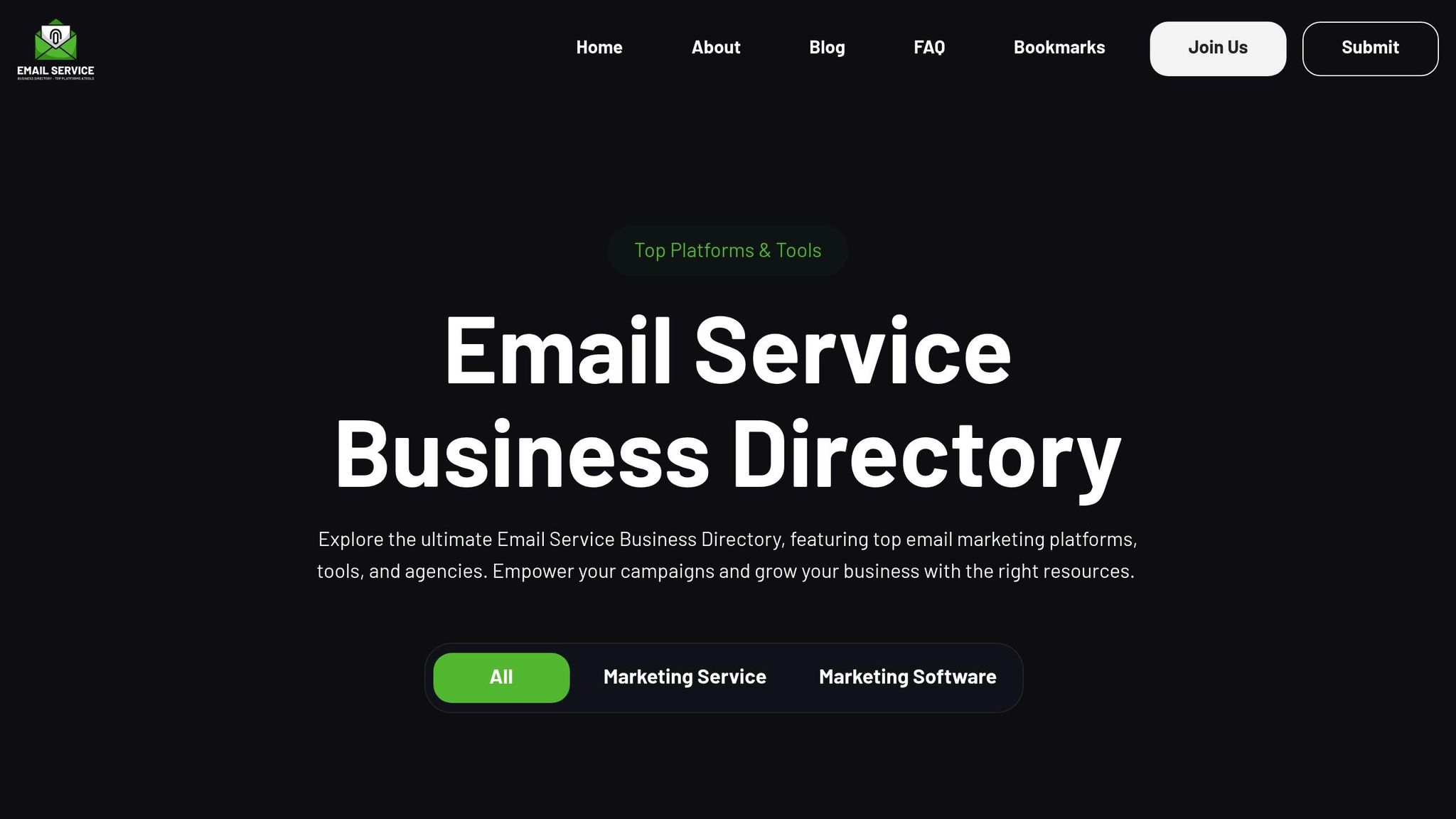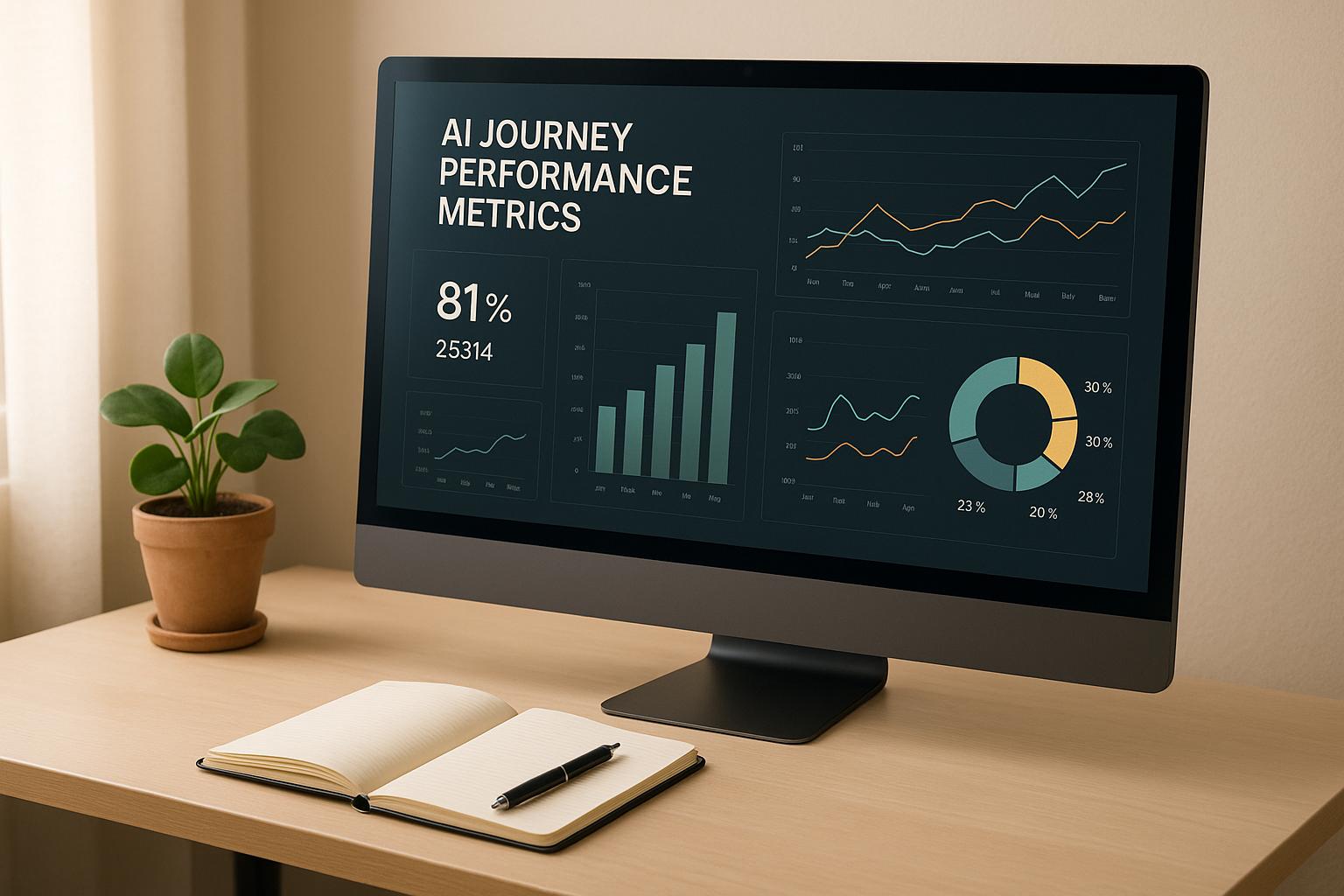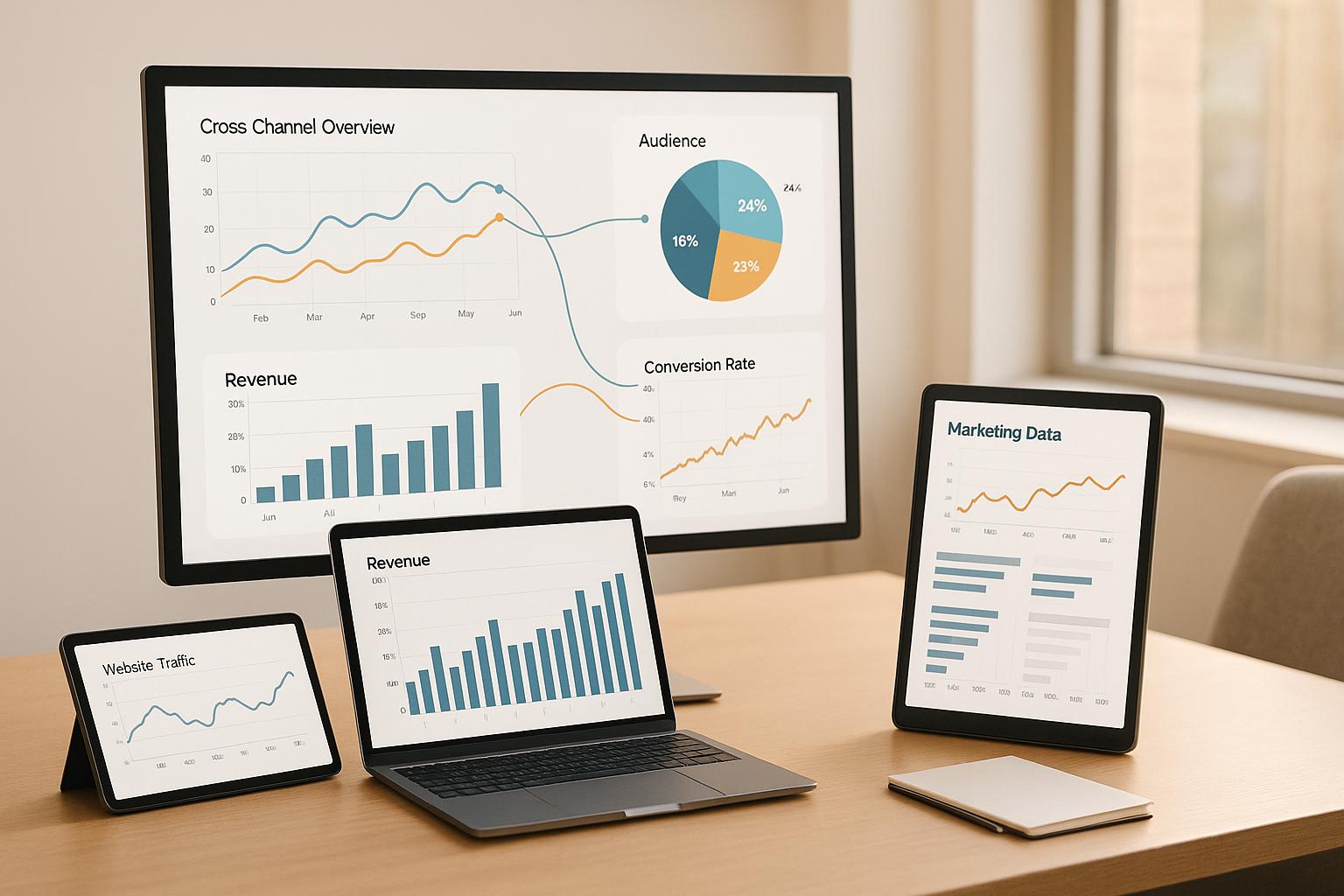Want better ROI from your marketing campaigns? Cross-channel tools can help. These platforms unify customer interactions across email, social media, mobile apps, websites, and even physical stores. By integrating data, automating workflows, and providing real-time analytics, they make campaigns more efficient and personalized.
Key Benefits:
- 126x more sessions per user when combining email, in-app, and push notifications.
- 25% more purchases with multi-channel messaging.
- 70% longer user lifetimes with WhatsApp integration.
How They Work:
- Data Integration: Create a unified view of customer behavior for precise targeting.
- Automation: Save time with triggered emails, social scheduling, and dynamic content.
- Analytics: Track ROI, customer lifetime value, and engagement metrics to adjust strategies.
Cross-channel tools simplify marketing, boost engagement, and drive higher returns. Ready to improve your campaign results? Keep reading to learn how.
ROI-Driving Features of Cross-Channel Tools
Customer Data Integration
Cross-channel tools bring together data from multiple sources, creating a unified view of customer behavior. This data integration supports precise targeting and segmentation by analyzing:
- Purchase history trends
- Preferred communication channels
- Optimal engagement times
- Product or service interests
- Response patterns
- Likelihood of conversion
- Behavior across different channels
By consolidating this information, marketers can craft campaigns tailored to individual preferences and behaviors, boosting overall effectiveness.
Campaign Automation Tools
These tools take the hassle out of repetitive tasks, freeing up time and improving campaign outcomes. Automation features that directly contribute to ROI include:
| Automation Type | How It Impacts ROI |
|---|---|
| Triggered Emails | Sends personalized follow-ups based on customer actions |
| Social Scheduling | Aligns post timing across various platforms for consistency |
| Ad Buying | Dynamically adjusts bids based on real-time performance |
| Content Delivery | Customizes messaging using behavioral insights |
This automation not only saves time but also ensures campaigns are more responsive and targeted, setting the foundation for real-time performance tracking.
Performance Analytics
Once automation is in place, real-time analytics take the lead in fine-tuning campaign strategies. These tools enable marketers to identify what works and quickly adjust for better outcomes. Key analytics features include:
- Multi-touch attribution to understand the impact of each interaction
- ROAS (Return on Ad Spend) tracking for individual channels
- Engagement metrics across platforms for a comprehensive view
- Customer lifetime value calculations to measure long-term profitability
- Analysis of conversion paths to optimize the customer journey
With these insights, marketers can make data-driven decisions, reallocating budgets and refining strategies to maximize returns.
Setting Up Cross-Channel Campaigns
Customer Segmentation Methods
At the heart of every successful cross-channel campaign lies effective segmentation. By combining various data points, you can create targeted audience groups that feel personalized and relevant. A commonly used three-tier segmentation model includes:
| Segmentation Type | Data Points | Campaign Application |
|---|---|---|
| Behavioral | Purchase history, browsing patterns, engagement rates | Automate follow-ups triggered by specific customer actions |
| Demographic | Age, location, income level | Adjust messaging and offers to align with distinct market segments |
| Psychographic | Interests, values, lifestyle choices | Shape content themes and creative strategies to match audience preferences |
Using this approach, you can leverage behavioral data to engage customers based on their actions and demographic insights to align campaigns with local preferences and spending habits. Once you’ve defined your audience, the next step is mapping their journey to ensure smooth and meaningful interactions.
Building Customer Journey Maps
To deliver a seamless experience, map out your customers’ interactions across all channels. Start by identifying the key stages of their journey:
- Awareness Stage: Pinpoint where potential customers discover your brand - be it social media, newsletters, or web searches. Ensure consistent visibility across these platforms.
- Consideration Stage: Study engagement patterns to craft targeted content that speaks to their interests and needs.
- Decision Stage: Synchronize promotions and messaging across channels to create a clear and persuasive path to conversion.
By understanding these stages, you can align your strategies to meet customers where they are, guiding them smoothly from discovery to purchase.
Using Data for Campaign Forecasting
Data is your crystal ball when it comes to predicting campaign success. By analyzing both historical and real-time metrics, you can uncover opportunities to maximize ROI. Here are two key approaches:
Predictive Analytics Models
These models use past campaign data to anticipate future outcomes. They help you pinpoint:
- Which customer segments are most likely to deliver value
- The best times to reach out for maximum impact
- The channel combinations that drive results
- Expected conversion rates, so you can plan accordingly
Performance Tracking Metrics
To measure and optimize your campaigns, focus on metrics that directly impact ROI:
- Multi-touch attribution to track how different channels contribute to conversions
- Channel-specific Return on Ad Spend (ROAS) to evaluate effectiveness
- Customer lifetime value predictions to prioritize high-value audiences
- Trends in engagement rates to refine future strategies
Choosing the Right Cross-Channel Tools
Must-Have Tool Features
When picking cross-channel tools, focus on features that directly impact your bottom line. Modern platforms should seamlessly integrate data across all marketing channels, enabling unified customer profiles and personalized messaging at scale.
| Feature Category | Key Capabilities | ROI Impact |
|---|---|---|
| Data Integration | Real-time syncing, unified customer profiles, multi-channel tracking | Boosts purchases per user by 25% |
| Automation | Workflow builders, trigger-based campaigns, dynamic content | Reduces time spent on repetitive tasks |
| Analytics | Multi-touch attribution, ROAS tracking, predictive modeling | Enables smarter, data-driven decisions |
| Scalability | API access, custom integrations, flexible user roles | Adapts to your business as it grows |
Data Security Requirements
As privacy regulations tighten, robust security measures are non-negotiable. Any platform you choose should comply with GDPR and CCPA standards to protect customer data and maintain user trust. Look for these key security features:
- Encryption: Safeguards data both at rest and during transmission.
- Access Controls: Implements role-based permissions and secure authentication.
- Audit Trails: Tracks data access and changes comprehensively.
- Consent Management: Simplifies collecting and managing user permissions.
These features are vital for ensuring compliance and safeguarding customer trust. Resources like the Email Service Business Directory can help you compare platforms with these capabilities in mind.
Email Service Business Directory Benefits

The Email Service Business Directory is a valuable resource for identifying tools that balance performance with compliance. It helps narrow down solutions tailored to your campaign goals and regulatory needs.
The directory’s detailed feature breakdowns make it easier to evaluate critical capabilities, such as:
- Advanced automation workflows
- CRM integration options
- Custom API access
- Dedicated IP addresses
- Priority technical support
For example, one enterprise user reported that using the directory significantly streamlined their platform selection process. This ultimately led to noticeable improvements in session engagement and user lifetime value.
sbb-itb-6e7333f
How to develop Cross-Channel User Journeys that can 4X your revenue
Conclusion: Cross-Channel ROI Results
The numbers are clear: cross-channel strategies significantly enhance marketing performance. The documented improvements highlight the impact of combining multiple channels into a unified approach.
Key Takeaways
Cross-channel tools deliver measurable gains in marketing ROI. Businesses leveraging these strategies report up to 126 times more average sessions per user compared to those relying on single-channel methods. Here’s a breakdown of how these tools drive results:
| ROI Factor | Result | Benefit |
|---|---|---|
| Unified Data | Better targeting accuracy | Higher conversion rates |
| Channel Integration | Streamlined customer journeys | Increased engagement levels |
| Automated Workflows | Smarter resource allocation | Improved operational efficiency |
By merging data integration, automation, and advanced analytics, businesses consistently achieve stronger ROI across their marketing efforts.
"Cross-channel strategies boost engagement and retention by delivering consistent, relevant messages across customer touchpoints".
Modern cross-channel tools also empower marketers with cutting-edge personalization capabilities. In fact, 90% of marketers report notable profitability gains when using personalized messaging.
Focus areas for success include:
- Unified Data Management: Consolidate customer data from all touchpoints to refine targeting precision.
- Automated Personalization: Leverage AI to customize content and boost user engagement.
- Performance Analytics: Apply multi-touch attribution to fine-tune channel investments.
FAQs
How do cross-channel tools boost customer engagement compared to single-channel strategies?
Cross-channel tools make it easier for businesses to connect with customers by ensuring a smooth experience across platforms like email, social media, and SMS. Instead of relying on just one channel, these tools allow companies to send consistent, tailored messages at the ideal time and place. The result? Messages that feel more relevant and help build stronger connections with customers.
By combining data from various channels, these tools provide businesses with deeper insights into customer behavior and preferences. This means campaigns can be more targeted, leading to higher engagement and, ultimately, a better return on investment (ROI).
What key features should I consider when selecting a cross-channel tool to boost my campaign ROI?
When selecting a cross-channel tool to boost your campaign ROI, focus on features that simplify your workflow and enhance targeting. Start by seeking tools with advanced audience segmentation - this lets you craft tailored messages for different groups across various channels. Automation features are another must-have, helping you save time while keeping your messaging consistent. Lastly, opt for platforms that provide real-time analytics, so you can monitor performance and make quick, data-informed tweaks.
The right tool can elevate your marketing game by streamlining processes and enabling more personalized campaigns, leading to better results and higher returns.
How can I protect data and stay compliant with privacy laws when using cross-channel marketing tools?
To keep your data secure and stay compliant with privacy regulations while using cross-channel marketing tools, start by choosing platforms that emphasize strong security features like data encryption, secure access controls, and routine audits. Make sure the platform complies with relevant privacy laws such as GDPR or CCPA, depending on where your business operates and the audience you serve.
On top of that, follow essential practices like getting clear, explicit consent from users before collecting their data, maintaining straightforward and transparent privacy policies, and keeping your team informed on the latest compliance updates. You can also rely on trusted resources, such as well-researched directories for marketing tools, to identify platforms that align with your security and compliance standards.


